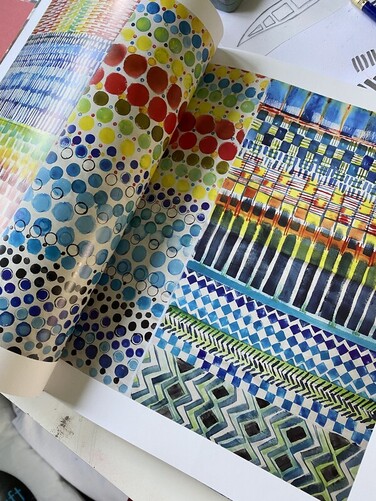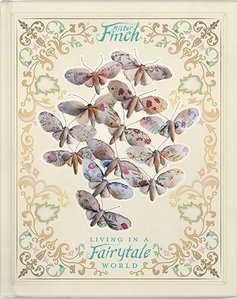|
Hand-Painted Textiles A Practical Guide to the Art of Painting on Fabric Sarah Campbell ISBN 978-1-78994-064-0 Herbert Press www.bloomsbury.com I was first introduced to the work of Sarah Campbell at the Fashion and Textiles Museum exhibition Liberty in Fashion in 2015. The exhibition featured the work of the Collier Campbell Colllective, namely Sarah and her sister Susan Collier who had designed for Liberty in the 80s. I was struck at the time by the colour and vibrancy of their work and I was lucky enough to meet Sarah at the exhibition and interview her for the online magazine Workshop on the Web. She is a lovely person and the colour shines out of her. Since then I’ve followed Sarah and seen how her designs gain in popularity with those people who have an interest and passion in fabric design. She runs workshops at the Fashion and Textile Museum (and one I believe that's coming up at the V&A) and her work always looks so bright and joyful. I was very excited to hear that Herbert Press were publishing her book on painting fabrics and asked me to review it. I am interested in pattern and surface design and although I have been looking at print on paper more recently, this book has jolted me out of my reverie. I have dusted off my textile paints, fabric swatches and brushes and am raring to go. The most striking thing about this book is that it is, like Sarah, very joyful, free and playful. Sarah makes no secret of the fact that her approach to work is grounded very much in her extensive knowledge of composition, colour, pattern and balance. But she gives the reader the freedom to try things out under her expert guidance and start to think about how patterns work and how we can create them ourselves. The tools that Sarah uses are those that are easily available, such as foam brushes, sponges, brushes and the humble potato. You are encouraged to try all the different tools you have to see what kind of marks they make, how to be creative with them and let your imagination and sense of play take over. There are simple projects along the way for those of us that need some guidance about where to make the marks or provide ideas about what you can do with all the lovely fabrics you will have created after getting stuck in. The pervading sense of play as a starting point for creativity comes across very strongly in the book. By making that first mark, you have somewhere to progress from. And by gathering your materials, colours, different types of paint and enthusiasm, you can start to experiment with what you like, what works and how to combine the different techniques to start to create your own unique patterns. Whether they are small motifs to repeat or larger scale panoramas becomes entirely up to you. They are many swatches pictured so you wouldn’t have any problem getting inspiration if you didn’t know where to start and lots of projects to showcase all the new skills you have learned. This is a book for all from the absolute beginner to find a starting point to the confident textile artist who needs some more spontaneity in creativity. Using colour and pattern in this way is the universal panacea for a grey existence and I cannot wait to take my new creations out into the world.
0 Comments
Living in a Fairytale World Mr Finch ISBN 978-0-9913419-7-9 Published by Glitterati Incorportated $50 / £30 Available through Amazon in the UK www.glitteratiincorporated.com This book has been highly anticipated all around the globe by fans of the textile artist Mr Finch. This book does not disappoint. For those who have glimpsed into his world of creatures and woodland flora and fauna through his Etsy shop, Facebook page and pins on Pinterest, his creations are brought together to form a cohesive whole and show how his work interacts to create a mythology of its own. A Preface isn’t usually the focal point of a review, but this one, written by Justine Hand, is so beautifully written and perfectly encapsulates the essence of what the book is about, that it requires a mention. She explains the world of Mr Finch in such magical terms, that you cannot wait to wade further into the book and explore. The book is very well structured. There is a conversation with Mr Finch, which is a short but perfect length, as it introduces the artist and his methods without overpowering the work that you will be seeing. The book is divided into sections according to the type of work it is: Insectum, Avialae, Funghi and Mammalia. Each section is filled with a huge number of photographs of the work with details provided at the start of sizes, what they are made of and interesting facts. The photographs are beautiful, and show off the detail and execution of each piece of work. Some are photographed on display, some in Mr Finch’s studio, and some in a slightly more surreal setting, such as one of my favourite photos, of a spider having a tea party and pouring a cuppa. You get to see the works in fantastic detail, some of the ways in which Mr Finch works (he talks of creating and storing a multitude of birds’ legs for future use) and different methods of presentation. There are quotes from the artist dotted throughout and these serve to create layers of this world that exists, where toadstools are the staple of fairytales, and his hares are always made with ears straight up, so that they are always listening. These snippets all add to your perception of a world where the animals assume human characteristics, and can be cloaked or dressed in ruffs or bow ties. Animals that we perceive as constantly moving and frenetic are caught in a tableau of stillness and serenity, and there is great beauty to be found in that. This book is such a wonderful investment and shows off the work of Mr Finch perfectly. In all of our mad lives, you could sit down with this book and lose yourself in it. |
AuthorBook Reviews on a variety of arts-related subjects. Please see Book Review page for an index of subject matter. Archives
March 2023
Categories |
Proudly powered by Weebly







 RSS Feed
RSS Feed